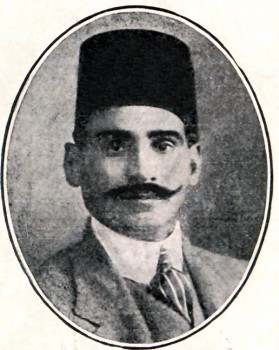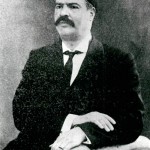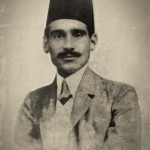The Arab Music Archiving and Research foundation (AMAR), in collaboration with the Sharjah Art Foundation (SAF), presents “Min al-Tārīkh”.
Dear listeners,
welcome to a new episode of “Min al-Tārīkh”.
Today, we will resume our discussion about ‘Abd al-Ḥayy Afandī Ḥilmī with Prof. Frédéric Lagrange.
In our previous episode, we discussed the dawr and talked about how ‘Abd al-Ḥayy Ḥilmī ignored the composer’s intentions, whether in the madhhab where he made changes at whim, or in the tafrīd where he did not abide by the shifts planned by the composer, or in the shifts from a waḥda to another… he even sometimes ignored some waḥāyid from the start. He lengthened certain sections and performed at whim, ignoring the melodic pattern or the dramatic pattern intended by the composer in the dawr.
Also, as we noticed in the first episode, he totally ignored the variety of beats in the muwashshaḥ and performed at whim: abiding by them or not. The same applies to the dawr that he also interprets at whim.
What about the free forms –free as to the rhythm, i.e. with no rhythmic cycle– that rely exclusively on the rhythm of the word’s measure, such as the taqsīm layālī, the mawwāl, and the qaṣīda mursala, and whose melody’s notes are improvised, i.e. with no melodic pattern, composition, or maqām? He chose everything, including the maqām and the pattern he wished to follow. All this is illustrated in the qaṣīda mursala, the taqsīm layālī, and subsequently in the mawwāl.
What do you think of the way he dealt with the forms allowing more freedom of action and improvisation?
The mawwāl may be the form that most allowed ‘Abd al-Ḥayy Ḥilmī to express his emotions, or the layālī he improvised to the bamb with surprising liveliness to conclude dawr and qaṣīda, as if he were performing a taqsīm to a full dīwān (octave) higher than the position of the maqām in a long and touching scream, as we heard at the end of the record-sides.
Concerning the mawwāl, let us listen to “Ṣabaḥ el-ṣabāḥ” to the ḥijāz.
(♩)
Let us discuss the tragic aspect: ‘Abd al-Ḥayy Ḥilmī’s voice was tragic and full of pain whose cause we know nothing about, and the contradiction between his singing voice that was always in the higher range, while his talking voice was in the qarār (low vocal range).
Let us start with the tragic characteristic in ‘Abd al-Ḥayy Ḥilmī’s voice and performance. In my personal opinion, his performance of qaṣīda ‘ala al-waḥda suffers to some extent from his neurotic temper, as it focuses less on building a consistent maqām pattern –such as with Al-Manyalāwī or Abū al-‘Ilā Muḥammad in the following generation–, and he limits it to one maqām. His mood almost imprisons him inside contorted and complicated repetitive phrases, and most of the qaṣīda muwaqqa‘a that he recorded were sung to the bayyātī maqām, unlike Sheikh Yūsuf al-Manyalāwī who recorded qaṣīda to all the maqām and even invented –as we have previously heard– the singing of qaṣīda ‘ala al-waḥda to the ‘ushshāq maqām.
‘Abd al-Ḥayy Ḥilmī had his own way in performing qaṣīda “Arāka ‘aṣiyy al-dam‘ ” to the sīkāh maqām in Zonophone’s beautiful recording where he tried unsuccessfully to improvise a new melodic phrase but had to go back to his habitual bayyātī pattern.
Let us listen to this recording then you will tell me what you think about it.
(♩)
He actually did this in “Arāka ‘aṣiyy al-dam‘ ”. He even went beyond it in dawr such as “Yā ma-inta waḥishnī” that demonstrated this very clearly. This dawr composed by Muḥammad ‘Uthmān is very consistent, and all the muṭrib recorded it with this structure.
‘Abd al-Ḥayy Ḥilmī started the dawr to the ḥijāzkār and ended it to the bayyātī. So it seems that he ignored the rules not only in qaṣīda, or in quasi-fixed patterns, but also in the very strongly built patterns: he did not care if the qaṣīda had to include a lot of improvisation like “Arāka ‘aṣiyy al-dam‘ ”, or like early dawr such as ““El-ward fī wagnāt bahiyy el-gamāl”, or even a dawr among the developed, evolved and very consistent ones such as “Yā ma-inta waḥishnī”.
Indeed… And I suggest we also listen to the last record-side of dawr “Yā ma-inta waḥishnī”.
(♩)
In conclusion, ‘Abd al-Ḥayy Ḥilmī was more spontaneous than Al-Manyalāwī and probably knew better how to stir emotions. But he was not as good as him in dealing with the half-composed sections through such an astoundingly engineered structure.
The question is: did he want this?
Mostly, he did not… you are right.
Exactly. He did not want this at all. He only cared about reaching salṭana and ṭarab, which made him happy first and foremost.
Moreover, ‘Abd al-Ḥayy Ḥilmī’s voice “wandered flirtatiously” (“Yatīh dalālan”)…
Always.
Talking about “Yatīh dalālan” and Sheikh Al-Manyalāwī, the latter’s recorded repertoire is very poor in Sufi heritage, unlike ‘Abd al-Ḥayy Ḥilmī… Let us talk about the works shared by ‘Abd al-Ḥayy Ḥilmī and Sheikh Yūsuf al-Manyalāwī: Sheikh Yūsuf al-Manyalāwī sang a part of “Yā layl inn al-ḥabība wāfa” that does not include any direct religious allusions, and improvised it ‘ala al waḥda, while ‘Abd al-Ḥayy Ḥilmī sang it to the Sufi melody –as a dhikr– that is still followed today, and added: “Yā Muḥammad, ‘alayka ṣalāt Allāh”…etc. i.e. he sang the religious part of this qaṣīda while Al-Manyalāwī did not.
What a paradox!
Exactly.
The second point is the following: he recorded “Tih dalālan fa-anta ahlun li-dhāka” as well as “Ghuṣnu bānun jabīnuhu al-badru”, the very famous Sufi song of praise to the prophet.
Isn’t it strange that ‘Abd al-Ḥayy Ḥilmī described as a drug addict, among many other things, recorded these qaṣīda, while pious and God-fearing Sheikh Yūsuf did not? Can you understand this? …There is some kind of a mysterious secret here.
We end this episode with this paradox and “Tih dalālan”, allowing ‘Abd al-Ḥayy Ḥilmī’s voice to wander in the firmament of Arab singing.
(♩)
Beautiful “Tih dalālan fa-anta ahlun li-dhāka”!
This work and many others are compiled in the ‘Abd al-Ḥayy Ḥilmī box set published by AMAR on the occasion of the centenary of ‘Abd al-Ḥayy Ḥilmī’s death.
Note that he went on recording until he reached the label. Both he and the disc ended at the same time. There is no space between the end of the last line and the label. The needle actually ruined a part of the label since it did not stop at the end of the disc and went over the label.
Dear listeners,
We have reached the end of our discussion about ‘Abd al-Ḥayy Ḥilmī.
We thank Prof. Frédéric Lagrange who entertained us with his excellent analysis.
We will meet again in a new episode of “Min al-Tārīkh” to discuss another figure or a new historical event.
“Min al-Tārīkh” is brought to you by Mustafa Said.
- 221 – Zakariyya Ahmed – 12 (1/9/2022)
- 220 – Zakariyya Ahmed – 11 (1/9/2022)
- 219 – Zakariyya Ahmed – 10 (11/25/2021)
- 218 – Zakariyya Ahmed – 9 (10/26/2021)
- 217 – Zakariyya Ahmed – 8 (9/24/2021)
- 216 – Zakariyya Ahmed – 7 (9/4/2021)
- 215 – Zakariyya Ahmed – 6 (8/28/2021)
- 214 – Zakariyya Ahmed – 5 (8/6/2021)
- 213 – Zakariyya Ahmed – 4 (6/26/2021)
- 212 – Zakariyya Ahmed – 3 (5/27/2021)
- 211 – Zakariyya Ahmed – 2 (5/1/2021)
- 210 – Zakariyya Ahmed – 1 (4/28/2021)
- 209 – W-al-Lāhi lā astaṭī‘u ṣaddak 2 (4/6/2017)
- 208 – W-al-Lāhi lā astaṭī‘u ṣaddak 1 (3/30/2017)
- 207 – Bashraf qarah baṭāq 7 (3/23/2017)



